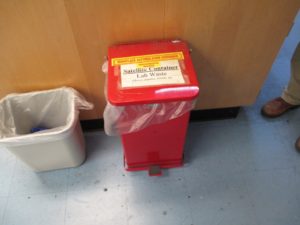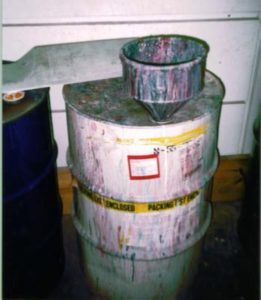Generators of hazardous waste should be aware of the packaging requirements of the U.S. Department of Transportation (USDOT) when shipping their hazardous waste off-site for final treatment and disposal: the packaging must be in good condition, approved by the USDOT for the use of hazardous materials, it must be labeled per DOT requirements, and it must be closed and sealed to prevent a release during transportation.
What aren’t as clear are the U.S. Environmental Protection Agency (USEPA) requirements for a “closed container” while the waste is accumulated on-site. In order to answer this question – which has come up many times during my training events – I relied heavily on a USEPA memorandum: Guidance on 40 CFR 264.173(a) and 265.173(a): Closed Containers.
Before we begin:
While the information of the USEPA guidance document referenced above remains correct, it regulatory citations are no longer accurate. The Generator Improvements Rule moved the locations of many regulations (read about the reorganization of the hazardous waste regulations) without changing their content. Where the guidance document refers to 40 CFR 264.173(a) and §265.173(a) for the closed container requirements, they can now be found at 40 CFR 262.16(b)(2)(iii)(A) for a small quantity generator of hazardous waste (SQG) and §262.17(a)(1)(iv)(A) for a large quantity generator (LQG).
Not sure of your hazardous waste generator status? Take this short survey |
My summary of the information contained in that document is below. Generators should check with their state environmental agency if it is authorized to enforce the hazardous waste regulations. Read: State Authorization Under RCRA
Scope and applicability:
The closed container regulations are applicable to both the large quantity generator of hazardous waste (LQG) at 40 CFR 262.17(a)(1)(iv)(A) and the small quantity generator (SQG) at §262.16(b)(2)(iii)(A). In both locations the regulations read exactly the same:
A container holding hazardous waste must always be closed during accumulation, except when it is necessary to add or remove waste.
No reference to a closed container is found in the regulations applicable to a very small quantity generator (VSQG) at §262.14.

The closed container requirements are also found in the regulations for the accumulation of hazardous waste in a satellite accumulation area at §262.15 (applicable to a SQG and LQG but not the VSQG). Here the language – modified by the Generator Improvements Rule – is more expansive than the above terse statement applicable to hazardous waste containers in a central accumulation area.
A container holding hazardous waste must be closed at all times during accumulation, except:
- When adding, removing, or consolidating waste; or
- When temporary venting of a container is necessary:
- For the proper operation of equipment, or
- To prevent dangerous situations, such as build-up of extreme pressure.
A “container” is defined at §260.10 as:
Container means any portable device in which a material is stored, transported, treated, disposed of, or otherwise handled.
I have found that for most hazardous waste generators the container of choice is a 55-gallon drum. However, note that the regulatory definition contains no limit on the size of container. Unless it is a fixed (i.e., non-portable) device and meets the definition of a tank, drip pad, or containment building, it is likely a container. This will include 55-gallon drums, test tubes, portable tanks of any volume, roll-off boxes, etc.
What is a closed container?
In the preamble to the original RCRA regulations published in 1980, USEPA stated its purpose in requiring “closed containers” for hazardous waste:
…Its purpose is, as it was originally, to minimize emissions of volatile wastes, to help protect ignitable or reactive wastes from sources of ignition or reaction, to help prevent spills, and to reduce the potential for mixing of incompatible wastes and direct contact of facility personnel with waste.”
While this gives us insight into USEPA’s purpose, it doesn’t tell us how we are to achieve that purpose. Think of the regulations as a performance standard with two goals: That containers be…
- Vapor tight to prevent emissions of volatile organic material (VOM); and,
- Spill proof even when the container may be tipped over in an accident.
Contact me with any questions you may have about the generation, identification, management, and disposal of hazardous waste Daniels Training Services, Inc. 815.821.1550 |
The best way to comply with these two performance standards is for the container cover to be properly secured to the container with snap rings tightly bolted and bungholes capped. However, methods may vary based on the type of waste generated and how & where it is accumulated. Consider the following:
- A VOM such as paint thinners, solvents, or fuels will require a tight fitting lid secured to the container to prevent ignitable or reactive emissions. If necessary to vent pressure inside the container to avoid explosions, pressure-vacuum relief valves may be used.
- A non-VOM such as some corrosive wastes or wastewaters may not require a lid secured to the container since there are little to no reactive or ignitable emissions. However, some measure to prevent a spill in the event the container is tipped over is necessary. This could be accomplished with a tight fitting lid, or by taking other measures to secure the container in a way to prevent it from being tipped over.
- If funnels or other devices are used to add VOM to a container, the performance standards of vapor tight and spill proof apply to the entire unit, meaning that if the funnel is left in place when waste is not being added or removed, it must be vapor tight and spill proof. Funnels of this type are available for purchase and should be matched to your facility’s exact needs.

- A non-VOM solid waste such as a wastewater plating sludge has little possibility of generating ignitable or reactive emissions, nor does it pose a great spill risk. In this case, a lid that covers the container top securely without the use of rings and bolts may suffice. If polysacks or roll-off containers are used for this kind of waste, the proper closure – such as a tarp or a roll-off – must consider the nature of the waste and the US EPA’s performance standards.
The short answer is that there are no clear regulations from the USEPA as to what is meant by a “closed container”. If any doubt exists, the best practice is to keep the container sealed and secured in a way that prevents the release of emissions and the possibility of a spill if the container is tipped over. If these measures cannot be taken at your facility you should consult your State environmental agency for further guidance. If State guidance is lacking, please refer to the USEPA guidance document upon which this article is based.
Daniels Training Services, Inc. 815.821.1550 |

